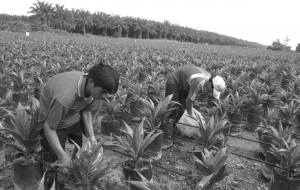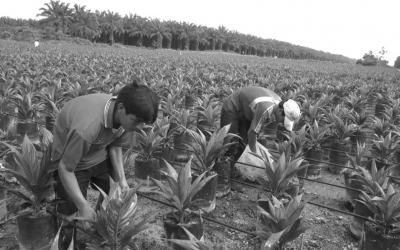Palmas del Espino
Harvesting Hope in the Upper Huallaga

Some years from now, these young plants will become highly profitable palm trees. Independent growers in the area are determined to switch from coca to palm. Photo by Flor Ruiz/DPM, El Comercio
The Peruvian amazon has long been a magnet for the desperate and adventurous. The hidden gold of the Incas, the rubber and oil booms, and the promise of free land through government-sponsored colonization programs all lured generations of landless peasants and unemployed youths to the jungle in search of a better future.
By the 1980s, the coca leaf had become king of the Amazon, particularly in the high jungle of the Upper Huallaga Valley (San Martin). Driven by growing international demand for cocaine, Peru became the world’s leading producer of coca leaves and the Upper Huallaga Valley became a key supply center for cartels in Colombia and beyond. Abandoned by the state, with no access to credit, and few markets for traditional agricultural products, many poor farmers moved to the region to cultivate coca as a path out of poverty.
The majority of growers (cocaleros), however, have remained at the base of the pyramid, both in terms of poverty levels and their role in the drug trade. As drug lords corrupted or replaced local authorities, growers had nowhere to turn for protection from the abuses of the narcos and their paid enforcers. In the mid-1980s, Shining Path guerillas (senderistas) began to dispute the power of the cartels and defend the cocaleros. They imposed their own violent regime. In efforts to regain control of the area, the Peruvian military also committed widespread abuses against the civilian population. According to Antonio Trujillo, president of San Martin Regional Federation of Oil Palm Development (FREDEPALMA) and Vice President of the National Confederation of Palm Growers and Oil Palm Companies (CONAPAL), “You could be killed at any given moment by the police, the narcos or the terrorists.”
The United States government has invested millions of dollars in the “War on Drugs” in Peru, promoting both forced and voluntary eradication and alternative income sources for cocaleros. Nevertheless, public sector efforts to replace coca with other sustainable agricultural activities have been largely unsuccessful because of the lack of financial and technical support, property land titles, seeds and markets for substitute products.
PALMAS FOR SANTA LUCIA
The history of Santa Lucia began this way, as a small town founded in the early 20th century by rubber extractors, followed by colonizers and migrants hoping to get rich through coca. During much of the 1980s, Santa Lucia was considered a “red zone,” where senderistas battled drug lords, counter-insurgency forces and anti-narcotics agents. Residents lived in a permanent climate of fear and insecurity.
Today, however, their story is different. Due to an evolving alliance with the largest private company operating in the Upper Huallaga—Palmas del Espino—Santa Lucia’s 3,200 residents and those in neighboring communities are turning voluntarily from coca to the cultivation of oil palm and related activities, offering them a genuine opportunity to climb out of poverty and live in peace. Four out of every five heads of households in Santa Lucia receive direct employment in this fashion. In addition to investing in housing and social services for the community, Palmas del Espino is helping independent farmers obtain land titles, credit and technical assistance for conversion to oil palm, promoting organization of the sector, and offering them a guaranteed market for the palm fruit the company turns into oil and other products. Palmas del Espino is the major philanthropic actor in Santa Lucia.
This alliance is mutually beneficial and market driven. Palmas del Espino developed good relations with its neighbors in a high-risk environment, and gained a chain of quality providers. But company executives did not always see it this way.
Founded 27 years ago by the Romero family, Palmas del Espino SA (“Palmas”) is dedicated to the cultivation of oil palm, palm oil extraction, and the manufacture of derived products, including cooking oil, shortening, soap and chocolate. Today the Palmas plantation and factory occupy nearly 24,000 acres and employ more than 1,500 people directly, including management, employees and agricultural workers. Total income in 2005 was $37.1 million. Palmas forms part of a conglomerate of companies owned by this family group and referred to as the Grupo Romero.
RAISING BARRIERS AND PASSING HURDLES
Getting to this win-win situation was not easy. When the plantation was inaugurated, the owners found it difficult to find enough workers for harvesting, because of competition for labor from the lucrative coca trade.
In 1984, the Shining Path attacked Palmas del Espino, destroying most of its installations and vehicles. This attack forced the company to invest heavily in a large security force. However, in 1987 senderistas managed to destroy the company’s convoy trucks, in attempts to close down the operation.
During the same period, about 150 people began to occupy 3,000 acres of Palmas property. The hostile political climate and presence of the Shining Path within the community made it especially difficult for the company to dislodge the squatters, and initial attempts were strongly resisted. Under the first administration of President Alan García (1985- 1990), the company was also hit hard by price subsidies on imported goods such as cooking oil, and nearly went into bankruptcy. It was not until the early 1990s, with the easing of price controls and the military defeat of the Shining Path that Palmas was able to recuperate its losses and develop into a stable and profitable company.
BUILDING TRUST
The context of violence and Palmas’ heavy security measures created considerable distance between the company and the community. Since the end of the 1990s, however, company officials decided to remove barriers and improve relations with the surrounding community. As Director and former General Manager (January 2001 – June 2006) Angel Irazola put it, “I don’t want to be closed in within our walls, afraid of the population… I’m interested in having the people beside me as partners, because if they are enemies I’m screwed.”
The first step involved increasing the amount and impact of company philanthropy. Although the Romero family had a history of charity, the management reached out to community leaders to define new priorities. These included investing in local schools and teacher training, equipping the local health post, and creating ways to provide employment to family members of company workers. By 2005, the company was investing about $110,000 per year, as well as the time of its professional staff, in social programs.
Nevertheless, company executives and community leaders alike realized that philanthropy alone would not lift them out of poverty, or keep them from coca. Thus, Palmas executives and staff stepped up efforts to promote oil palm cultivation among local independent farmers. The company sells them seedlings at cost from its greenhouses, offers technical assistance and training in oil palm management, and provides guaranteed markets at fair prices. Palmas has also promoted social capital through encouraging organization of palm growers at the local, regional and national levels and providing them direct access to market information and technology.
FROM SQUATTERS TO ASSOCIATES: THE JOSÉ CARLOS MARIATEGUI ASSOCIATION
Palmas executives took yet another step with the squatters on their plantation, supporting an unprecedented development and credit program that converted land invaders into property owners and company associates.
In 1990, local authorities awarded legal status to the squatter families, creating the José Carlos Mariategui caserio or village (JCM) even while their property dispute with Palmas was unresolved. After a series of conflicts and meetings over the years, the company reached an unprecedented agreement with JCM, offering to give them half of the occupied land, in exchange for leaving the rest. This offer was accepted in 2000, through direct consent from each family involved. In 2001, almost 70 families—including some of the original squatters that remained in the area—were given titles to the land, on which they freely cultivated rice, corn, papaya, beans, bananas and the inevitable coca leaf.
However, by 2003, it became clear that land titles alone would not guarantee a sustained income for JCM families. They were still living at subsistence level, and a number of them began to sell or abandon the land. At that point, company officials decided to promote the cultivation of oil palm among these families.
The main barrier to palm cultivation is that the plants require four years of financing and cultivation to bear fruit and hence generate income, and none of the JCM families had the resources to wait. Nor would any financial institution give credit to such poor peasants. (The independent farmers who did cultivate palm generally cultivated abandoned palm trees or got their start up capital from coca leaf sales). In this case, Palmas took another step forward, helping 54 associated families that wanted to grow palm to negotiate a loan of $1,090,000 from Peru’s largest financial institution, the Banco de Credito, guaranteed by the families’ land titles and backed by Palmas itself, which would be responsible for managing the credit.
Starting next year, the families of the JCM association expect to receive at least $800,000 a year ($650 per acre), a major income for a community that had previously lived at subsistence levels. They will use half of that over the first five years of harvest to repay their loan, thus producing a yearly net income of $400,000. Properly managed, their palm trees can be harvested for at least 25 years, so this is highly profitable.
Although the annual income generated by palm is still less than that of coca leaf, there are major advantages: it is legal, has low risk and low maintenance costs, and provides a constant income over time, with expert technical assistance available and a guaranteed market in Palmas (or elsewhere). However, it does not resolve the broader policy challenge posed by illicit drug trafficking. Without more effective efforts to reduce international demand, and extend this kind of market-linked crop substitution to other areas, coca leaves will still be grown for the drug trade in broad stretches of Peru, Bolivia and Colombia.
Due to the gradual confidence building between Palmas and JCM and the satisfactory resolution of the land invasion, almost all of the JCM families are now optimistic about their prospects for generating income and educating their children through palm cultivation. Their example, in turn, has motivated other peasants in the area to seek a similar path, away from subsistence agriculture or illegal coca and toward the profitable palm. As the former president (November 2003 – July 2006) of the José Carlos Mariategui Association, Noe Medina, put it, “We grew coca but we’re tired of all the problems linked to terrorism and drug trafficking. Now we have great expectations with this oil palm project. I have children, a family, and we are fine now.”
Fall 2006, Volume VI, Number 1
Related Articles
Editor’s Letter: Social Enterprise
The red and orange leaves of autumn drift past my window. It’s hard to believe that more than two months have gone by since I returned to ReVista from a year’s sabbatical on a Fulbright Fellowship in Colombia.
Review of Effective Management of Social Enterprises: Lessons from Businesses and Civil Society Organizations in Iberoamerica
This excellent book is the product of a collaboration of leading universities in Latin America and Spain under the leadership of the Social Enterprise Knowledge Network and with support of the AVINA Foundation….
Review of Running the Obstacle Course to Sexual and Reproductive Health: Lessons from Latin America
Although the idea of learning from Latin America is too often counterintuitive for readers used to viewing the world by default through the lens of the north, the continent regularly generates political …




